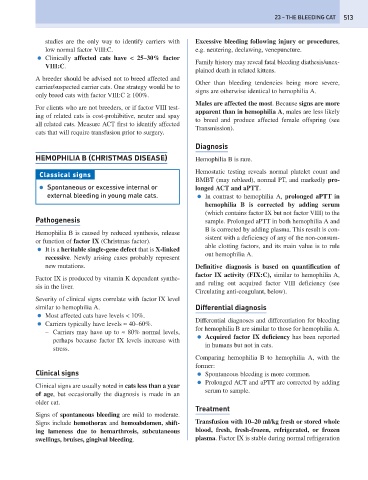Page 521 - Problem-Based Feline Medicine
P. 521
23 – THE BLEEDING CAT 513
studies are the only way to identify carriers with Excessive bleeding following injury or procedures,
low normal factor VIII:C. e.g. neutering, declawing, venepuncture.
● Clinically affected cats have < 25–30% factor
Family history may reveal fatal bleeding diathesis/unex-
VIII:C.
plained death in related kittens.
A breeder should be advised not to breed affected and
Other than bleeding tendencies being more severe,
carrier/suspected carrier cats. One strategy would be to
signs are otherwise identical to hemophilia A.
only breed cats with factor VIII:C ≥ 100%.
Males are affected the most. Because signs are more
For clients who are not breeders, or if factor VIII test-
apparent than in hemophilia A, males are less likely
ing of related cats is cost-prohibitive, neuter and spay
to breed and produce affected female offspring (see
all related cats. Measure ACT first to identify affected
Transmission).
cats that will require transfusion prior to surgery.
Diagnosis
HEMOPHILIA B (CHRISTMAS DISEASE) Hemophilia B is rare.
Hemostatic testing reveals normal platelet count and
Classical signs
BMBT (may rebleed), normal PT, and markedly pro-
● Spontaneous or excessive internal or longed ACT and aPTT.
external bleeding in young male cats. ● In contrast to hemophilia A, prolonged aPTT in
hemophilia B is corrected by adding serum
(which contains factor IX but not factor VIII) to the
Pathogenesis sample. Prolonged aPTT in both hemophilia A and
B is corrected by adding plasma. This result is con-
Hemophilia B is caused by reduced synthesis, release
sistent with a deficiency of any of the non-consum-
or function of factor IX (Christmas factor).
able clotting factors, and its main value is to rule
● It is a heritable single-gene defect that is X-linked
out hemophilia A.
recessive. Newly arising cases probably represent
new mutations. Definitive diagnosis is based on quantification of
factor IX activity (FIX:C), similar to hemophilia A,
Factor IX is produced by vitamin K dependent synthe-
and ruling out acquired factor VIII deficiency (see
sis in the liver.
Circulating anti-coagulant, below).
Severity of clinical signs correlate with factor IX level
similar to hemophilia A. Differential diagnosis
● Most affected cats have levels < 10%.
Differential diagnoses and differentiation for bleeding
● Carriers typically have levels ≈ 40–60%.
for hemophilia B are similar to those for hemophilia A.
– Carriers may have up to ≈ 80% normal levels,
● Acquired factor IX deficiency has been reported
perhaps because factor IX levels increase with
in humans but not in cats.
stress.
Comparing hemophilia B to hemophilia A, with the
former:
Clinical signs ● Spontaneous bleeding is more common.
● Prolonged ACT and aPTT are corrected by adding
Clinical signs are usually noted in cats less than a year
serum to sample.
of age, but occasionally the diagnosis is made in an
older cat.
Treatment
Signs of spontaneous bleeding are mild to moderate.
Signs include hemothorax and hemoabdomen, shift- Transfusion with 10–20 ml/kg fresh or stored whole
ing lameness due to hemarthrosis, subcutaneous blood, fresh, fresh-frozen, refrigerated, or frozen
swellings, bruises, gingival bleeding. plasma. Factor IX is stable during normal refrigeration

